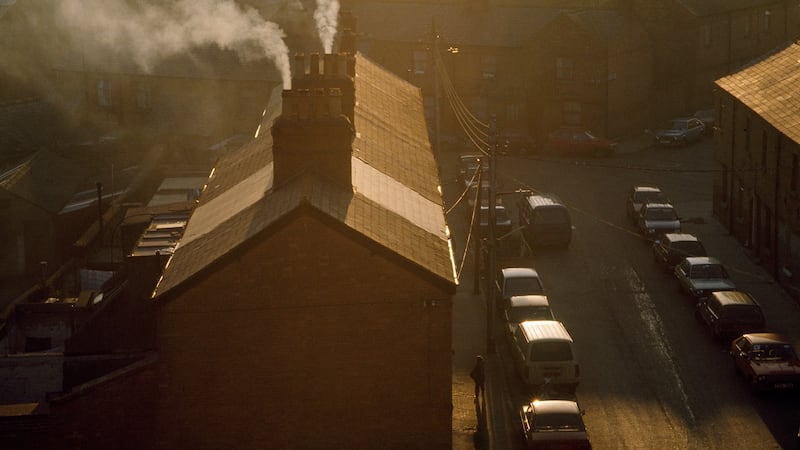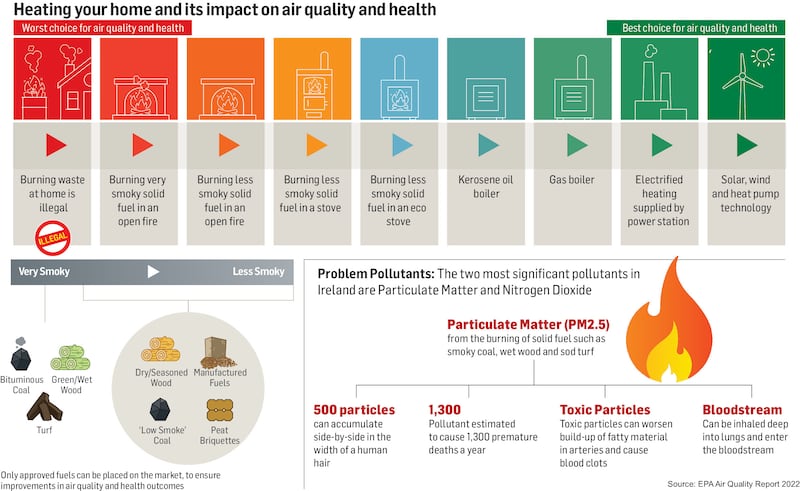As we face into winter, the latest findings on Irish air quality by the Environmental Protection Agency (EPA) could not be more timely. Ireland has a standout problem arising from the burning of solid fuels in domestic settings that poses a substantial risk to public health.
In 2022, air monitoring results from EPA stations across Ireland show fine particulate matter (PM2.5), arising mainly from burning solid fuel in our homes, and nitrogen dioxide (NO²) mainly from road traffic, remain the main threats to good air quality. High levels of these pollutants exceeded World Health Organisation (WHO) guidelines in most large urban areas at some point last year.
These pollutants are often associated with cold, still weather from late autumn through to early spring, when periods of poor air quality occur, though, fortunately, they are usually short-term.
The fact that most householders continue to wrestle with an energy crisis is likely to be compounding the threat. Leading Irish air pollution experts in September 2022 warned that burning highly polluting solid fuels – such as coal, peat/turf and wet wood – was likely to increase as people avoid expensive gas and electricity, while also in some instances defying a nationwide smoky coal ban introduced last year.
READ MORE
The most worrying finding is that “most of Ireland did not meet the WHO guideline for PM2.5 of 5 μg/m3″. Most of the country did meet the WHO guideline for nitrogen dioxide (NO2) of 10 μg/m3, though the EPA found elevated concentrations along the major urban road network in our larger cities.
The report confirms PM2.5 is the biggest air pollution threat to human health in the Irish context, giving rise to some 1,300 premature deaths annually.

PM2.5 particles are less than 2.5 micrometres in diameter. They are invisible to the naked eye and small enough to penetrate deep into our lungs. Exposure to these tiny particles dominates the health harm from air pollution and is the leading environment risk factor for early death.
The pollutant comes from burning of solid and liquid fuels; through power generation, domestic heating, motor traffic and agriculture. It can also form in the air from chemical reactions between other pollutants. The EPA says, however, that the burning of solid fuel in homes is the prime source of PM2.5 in Ireland.

[ Turf remains ‘important fuel’ in rural Ireland, says McConalogueOpens in new window ]
The EPA sets out steps to reduce PM2.5 pollution from home heating, including avoiding solid fuels if you have an alternative cleaner heating system or changing how you heat your home by moving away from smoky fuels and using cleaner heat sources. It confirms the health benefit from making homes more comfortable by increasing/improving insulation while availing of supports available through the national retrofitting scheme.
On NO² pollution from transport, it advises leaving the car at home “if you can for one day a week” – and walking, cycling or taking public transport. It also highlights the benefits of carpooling, working from home for part of the working week and switching to an electric vehicle, in reducing air pollution.
A recent investigation led by the Guardian revealed “a dire picture of dirty air” across Europe, with 98 per cent of people living in areas where levels of PM2.5 are exceeding WHO guidelines using innovative sourcing of critical data. Much of Ireland falls into that category, notably people living in Dublin, along the east coast and in Cork, Limerick and Waterford. The bottom line is that nearly every citizen of Europe is breathing unhealthy air.
[ EPA calls for nationwide ban on smoky fuels in open fires and stovesOpens in new window ]
Last week, the European Parliament voted to adopt the WHO guidelines on PM2.5 by 2035. The law, which must still be finalised in negotiations with the European Council, would set a legally binding limit for annual PM2.5 concentrations of 5µg/m3, down from 25µg/m3 today.
The Government’s new clean air strategy introduced this year commits to adopting the more stringent WHO guideline values by 2040 compared to EU limits. It has already encountered difficulties in curbing use of turf in domestic settings. Making the transition to ensuring cleaner air for all is likely to prove challenging in spite of the immense returns from both a public health and climate perspective.














